I have always been intrigued by the story of Che Guevara, that iconic communist revolutionary who started out on a motorcycle adventure through South America and ended up rocking the communist and democratic worlds in the 1960’s. His eventual demise in the mountains of a remote part of southern Bolivia propelled him to legend. After reading a biography on this enigmatic, controversial and inspirational leader, a small itch started within to go to the very schoolhouse where he met his end. Like any history buff, I strive to stand in the very place that history is made. There is no substitute to experiencing a place firsthand. The smell, the taste, and the sounds one absorbs in a historical location always delivers a reflection that is profound, personal and moving. Bolivia was on the list and one day I would go.
Then, one day, a video was sent to me by an acquaintance who had ventured to Bolivia on a motorcycle from the United States with a couple of friends. It was a shaky handheld video of a waterfall cascading over a road along a precipitous cliff. I sat up to watch it. Though the video was rough, it conveyed all the elements of an epic motorcycle adventure. This video was shot on the famed “Road of Death” in Bolivia and all it did was made me want to go more!
Fast forward a few years, and it finally came to pass that I put together what I thought would be an adventurous scouting trip through Bolivia, fueled by Che and the Death Road. I wanted to connect the two in a journey through this landlocked and rugged South American nation.
Maps were laid out and an itinerary was decided upon. Invitations were sent out, and riders committed. Airplane tickets were purchased, vaccination shots were received, passports were stamped. So, after over a year of planning and preparation, I finally stepped off the plane in Cochabamba in southern Bolivia. At long last I was in Bolivia and the adventure was about to begin!
Dates are set for our 2017 Bolivia “Che and Road of Death” Adventure.
Click here to learn more about this trip.
Sunday, November 6th — Cochabamba, Bolivia
This would be the official arrival day of the tour. I had been in Cochabamba for 4 days already, preparing for the trip. This included: checking out the bikes, meeting the local operator, discussing the details of the trip, walking around town, changing money, and going for a day ride to altitude.
The local operator was a kiwi-born man by the name of Cory Rowden, who had lived in Bolivia for over 16 years. His parents had brought him to Cochabamba as missionaries and he had finished out his primary schooling here. After which, he returned to New Zealand to finish university. When he graduated, he decided to ride a motorcycle from Ushuaia to Prudhoe Bay, and on his way north, he stopped in at his old stomping grounds in Cochabamaba. That is where he met his future wife and well, I suppose you can guess the rest of that story… His passion for motorcycling led him to start Bolivia Motors.
I had never worked with Cory but the minute I met him I knew he would be a solid part of this adventure. He would also be guiding this trip and I truly looked forward to working with him.
One of the riders had arrived early. John was from Boston, and had been on several MotoQuest rides. Over the years, we had become good friends and so it was fun to share the first few days of exploring the city and a day ride out of Cochabamba with him.
During that ride, we found a dirt road that wound up and around the mountains far above the paved highway. We arrived at a point where we had to turn back and we were pretty far off the grid at this point. No one was around and we were surrounded by sweeping mountain views. I turned to John and asked him if he wanted to take that other road that seemed to climb higher and more remote and he replied with a coy smile “I have a hard time saying no.” That was John.
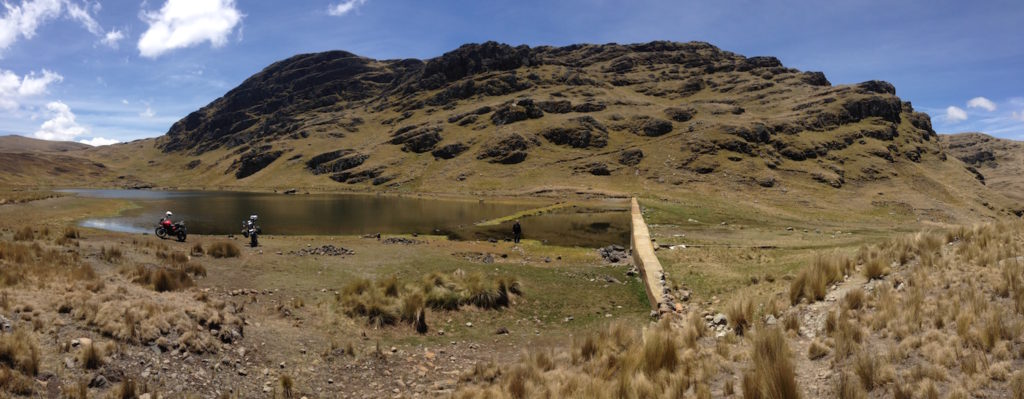
The group arrived in waves on Saturday and Sunday. I spent most of the days going to and from the airport and the hotel. It is always nice to get off a plane to see a familiar face, so I make it my priority to be there when riders come through the gates. On the taxi ride to the hotel, I would go over the details of the trip and hand them a modest gift package complete with a classy customized shirt, a hat and a buff (sort of a gator you can use as a neck warmer and such). I would go over the schedule and money and answer any questions they may have.
I had ridden personally with every rider on the trip except two. Those two riders had come highly recommended by other riders and MotoQuest guides. Scouting trips are first-run affairs and they do not always go as planned. I try to make them as smooth as possible, but not having been to a place before can make it so we come in after dark or have to revert to a “Plan B”. The last thing the group needs is a high-maintenance whiner to spoil the experience for everyone. So, I always hand-pick the riders for the scouting trips. We would need to rely on each other and everyone would be expected to pitch in and help if needed.
There would be 11 of us in all, from the USA, UK and Brazil. Most of them had ridden with me 3 or more times, all over the world. They came from various backgrounds but all shared the same zealous love for adventure and adversity. They were the types of people that had endless curiosity and energy to explore. They would be the “Guinea Pigs” in Bolivia.
The cast of characters would be: Leo from San Francisco (originally from Brazil), Walter from New Jersey, Al from Los Angeles, Gregory from Los Angeles, Craig from Missouri, Tim from Colorado, Mike from Texas (excuse the English accent!) , Ian from the UK, Iain, also from the UK (we call him “Angry Iain” so as to not get him mixed up with the other), and Howard from Alaska.
In the lobby of our hotel at 3PM with helmets, riding jackets, passports, and driver’s licenses, we boarded taxis and sped off to the motorcycle depot. We would be picking up the bikes and riding them back to the hotel that afternoon. At the shop, passports were copied, bikes were scrutinized for damages and Cory led a rider orientation, going over traffic nuances, group riding style and the fallible infallible: the buddy system (the system we use as a group to keep on the same route).
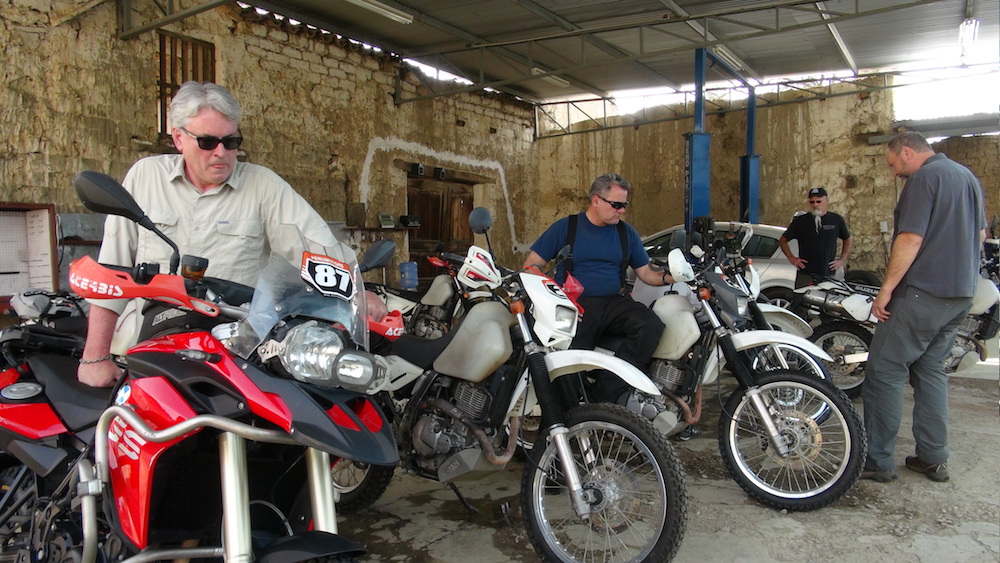
After the briefing, we donned our helmets and sped out into the chaotic Bolivian traffic. Cory led the group into the city on the main artery, then suddenly veered right to a side street. Suddenly, we were all climbing a steep and bumpy dirt road complete with loose rocks. Talk about being thrown to the sharks! We had hardly worked through the gears once on these bikes that were new to us, and now we were on the pegs and giving it all we had just to stay upright. (Later, some of the riders laughed and chided that this was Cory’s way of testing us to see if we were up for the challenge of riding the Bolivian roads.)
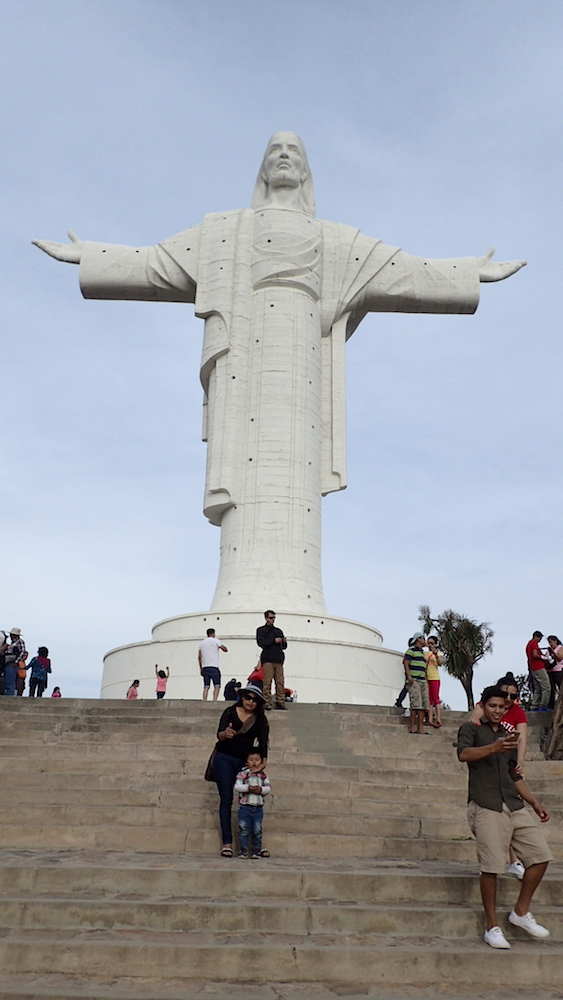
We took another small detour and climbed to the top of a hill where a prominent statue of Jesus presided, hand spread, over the city of Cochabamba. The light of the day was fading and colors over the surrounding mountains and roof tops into the distance was a pleasant delight. On the way back down the hill and into the city, John’s back tire went flat, so I motioned the rest of the group to continue to the hotel behind Cory as I pulled the tool kit out to take off the rear tire. Our support truck and crew (Carlos and Diego) arrived soon after to fix the tire and before long we were all back at the hotel.
A few minutes before dinner and all the riders were quietly engaged in strapping on bags to their bikes, affixing gopros, and adhering pillows to the seats of the bikes. Pillows? Well, all except two of the bikes were the Suzuki DR 650’s. It’s a great bike for what we were going to do but the seat is so hard that if you put a piece of plywood on it, you would be better off. Two of the riders were going with the BMW F800 GS, and the rest of the group would be sure to make fun of them for their posh choice!
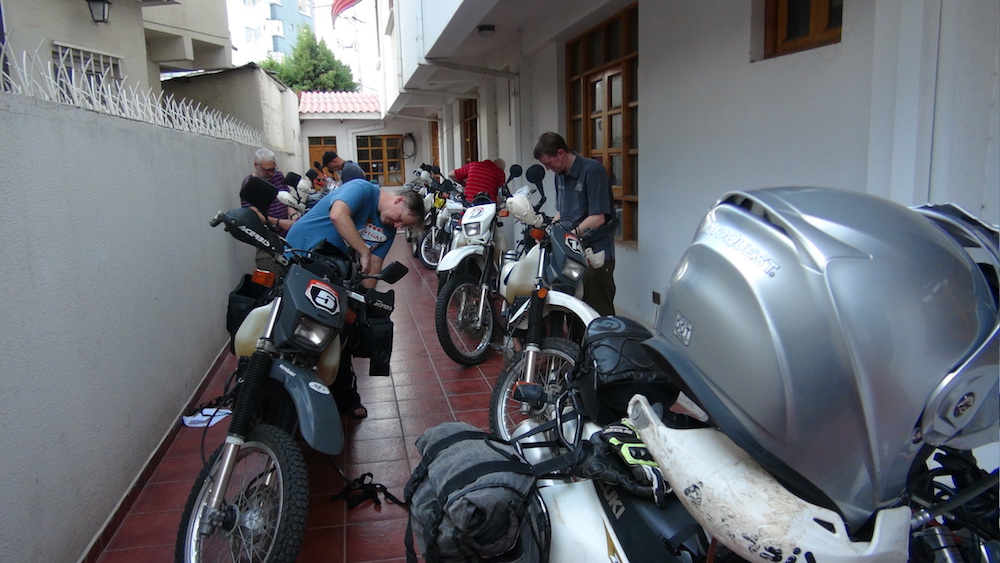
Soon after, we gathered again and walked a few blocks to a nearby restaurant. We had reserved the upstairs porch table to seat all 15 of us. The night air was pleasantly warm and comfortable. Drinks were served and we toasted to good memories and a safe journey. The evening carried on with stories and laughter. The rare form of camaraderie was already starting, unique to motorcycle travel. We would be traveling together for nearly two weeks and by the time it would be over, unforgettable memories would be made and lifelong friendships would be forged. We were off to a great start.
Monday November 7th — Cochabamba to Valle Grande
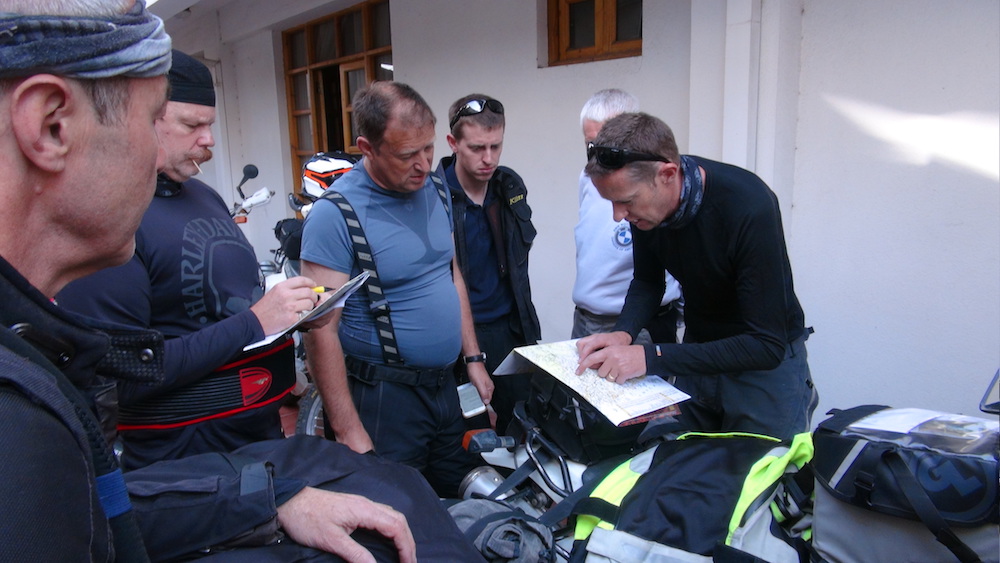
As we were making our way out of town I was struck by a profound delight: We were on an adventure! I was the last of 13 motorcycles weaving in and out of traffic. The scene was inspiring and you could only get excited about what lay ahead. Something special happens when you, after so many months of planning, finally feel the wind through your helmet and work through the gears of the motorcycle. Add to this the epic scene of a line of riders, strung out over two city blocks, riding staggered formation, heading into the unknown. If that does not get your blood going, then you might want to stop reading this now!
We immediately started to climb out of the city on one of the busier arteries of commerce in Bolivia. It was a two-lane road featuring lumbering trucks belching thick black exhaust, teetering mini buses full of passenger, midsize trucks and fast-paced taxis. Traffic laws, as we know them in the USA, were out the door. Passing could be on either side of the vehicle. Double lines meant nothing. Turn signals were rarely used. Every corner hosted the possibility of a truck coming at you in your lane. You had to keep vigilant because at any time you might need an out. This could be construed as dangerous – especially on a motorcycle – but it’s hard not to love the feeling of freedom you have when riding in third world traffic!
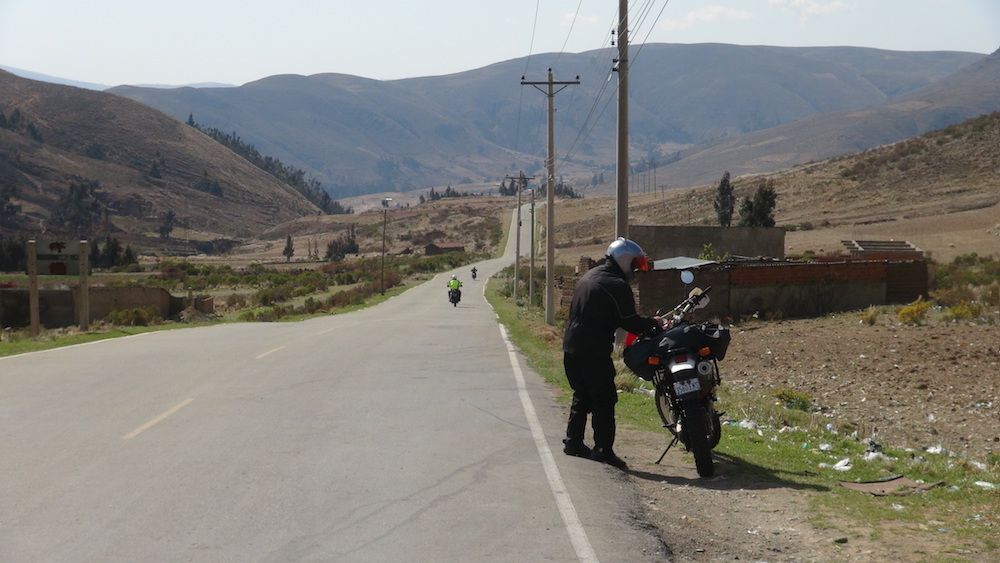
We topped out at 13,000 feet right away and quickly descended to a small town where we took a road to the south. Suddenly, almost all the traffic dropped off and it was just our group, strung out along the road over miles, clipping along the lovely Bolivian countryside. Oxen being driven by farmers, small plots of corn and potatoes, and mud-brick homes dotted the landscape. We were now in Bolivia and the smells of Eucalyptus and the panorama of mountains near and far drove home the point that we were now doing what we came here to do: experience the real Bolivia.
We stopped for a while at a small market town. It was an indigenous cross roads between the high mountains and the distant amazon basin. We filtered down to the local market. An open-roofed pavilion housed dozens of tiny stalls where locals sold anything from knives to soap to scraps of meat. Sheep’s heads, tongues and hearts, motorcycle tires, frying fish…this was a place, we agreed, that all Americans should experience first hand. This was where the world really was – not the sanitized and sterile mall just around the corner. The locals were adorned with brightly colored saucer hats affixed with plastic flowers, brightly colored sweaters and flaring skirts. Most women wore two neatly braided pony tales. The locals went about their business and we walked almost invisible amongst them.
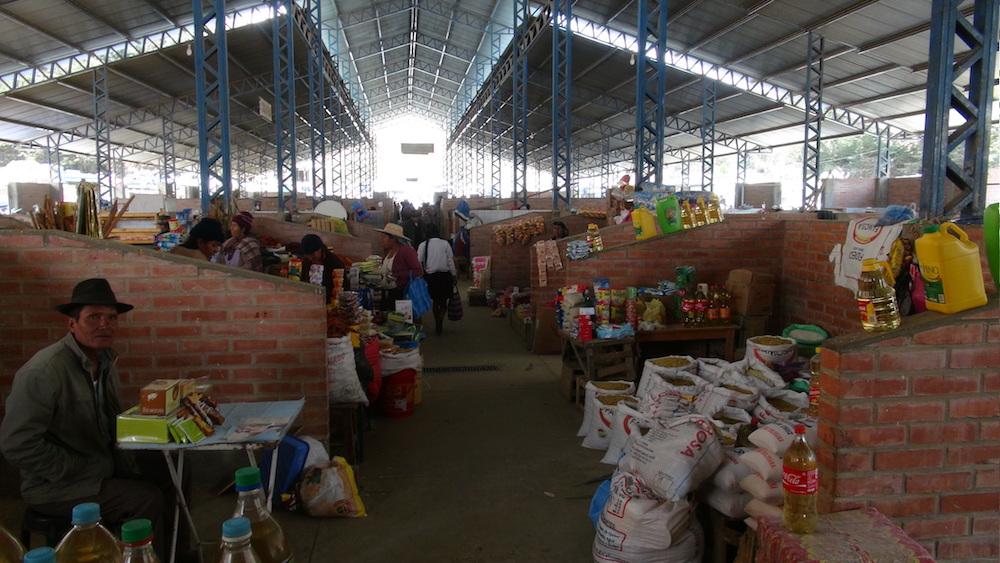
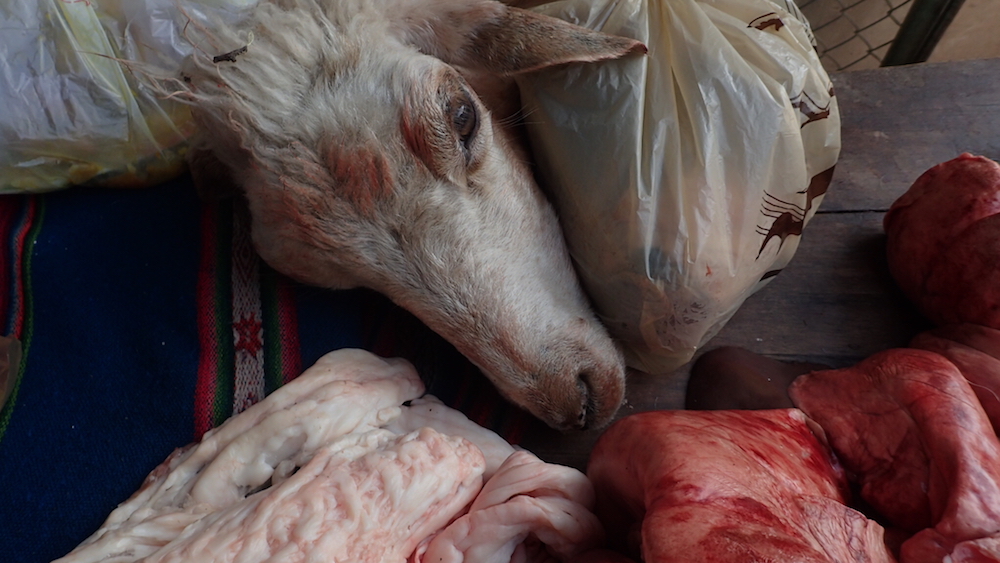
After the stop, we climbed back into the mountains and spent most of the day riding almost 100 miles of road construction. Dust, dump trucks, and road crews were strewn along the entire way. They paid little or no attention to us riding through the middle of it all. It was surreal mixture of “Mad Max” meets the dust bowl. We even passed a water truck which sprayed us as we passed. “That was refreshing” commented Mike.
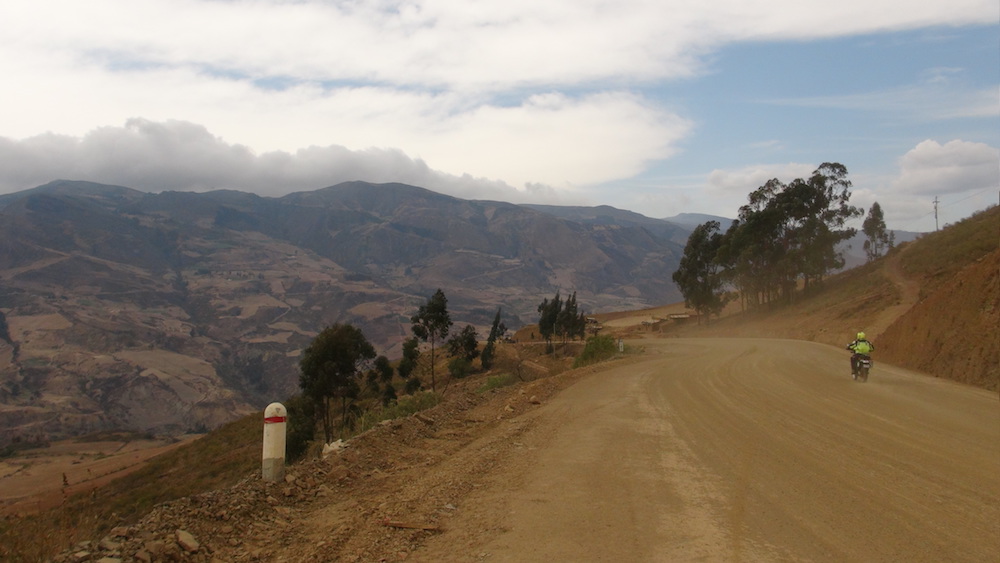
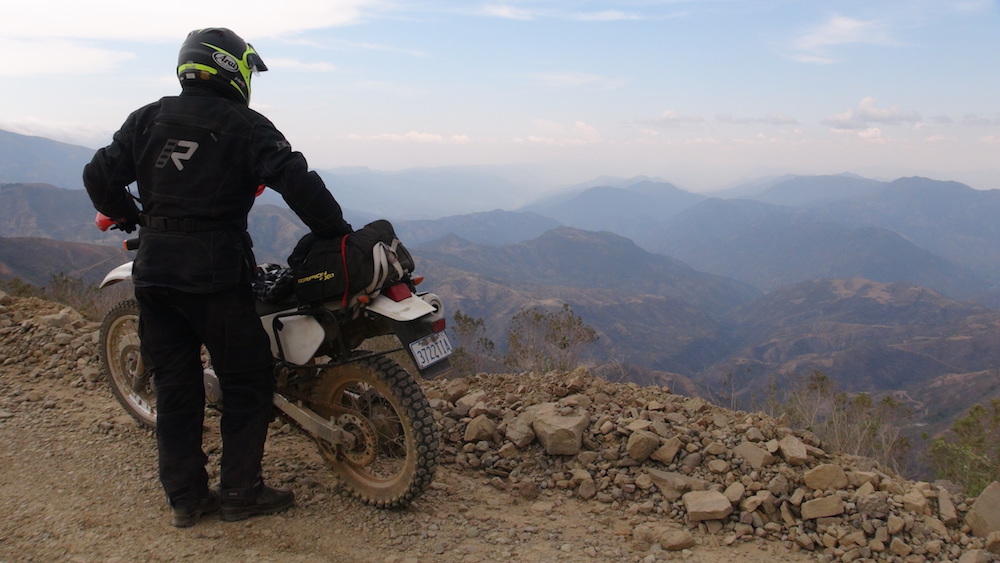
The mountains seemed to go on forever and in all directions you could see the patchwork of small farm plots. There was no place where land was not being utilized. After riding for hours, you started to wonder if there was any place in Bolivia that has not been touched by the hand of man.
As if to answer our question we came to a point in our Southeasterly migration where the plants all changed. An entirely new order of bushes and trees appeared. We descended in elevation and this gave way to cactus and scrub brush. We had gone from 13,000 feet down to 4,500 and the temperature rose as we finished the day along a broad valley to our destination. The road returned to pavement for the last part and we pulled into the town of Valle Grande an hour before sunset. The cobblestone streets and quaint plazas, tiled red roofs and church steeples welcomed us. As I got off the bike, I immediately fell in love with the place.
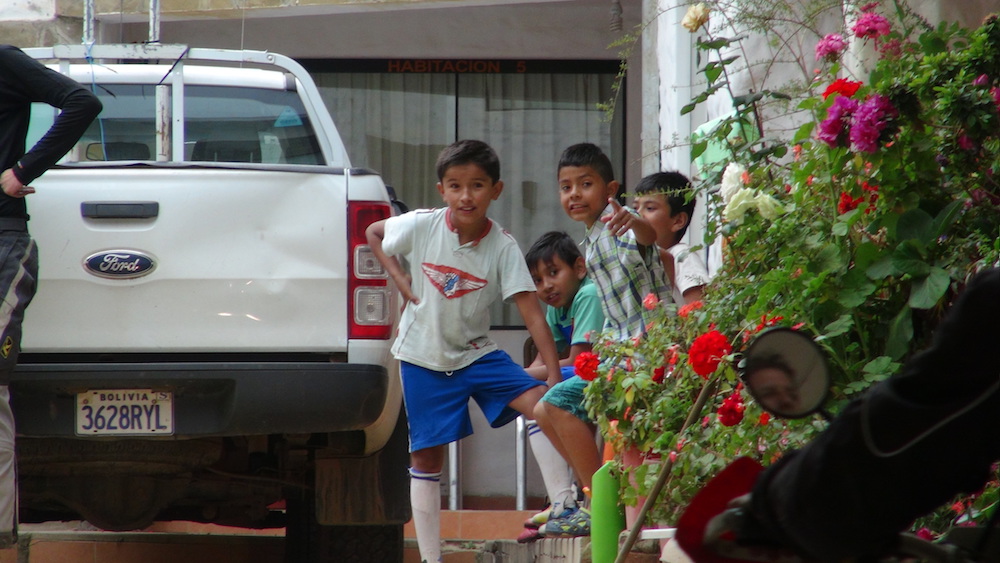
We walked the streets before and after dinner and there was not a foreigner in sight. Looking out over the valley and you would think you were in Italy. The air was again a perfect temperature and as the night came on we gathered on the veranda overlooking the city of our hotel and recounted the day’s activities. The variety of landscapes of Bolivia were astounding and we had only just begun!
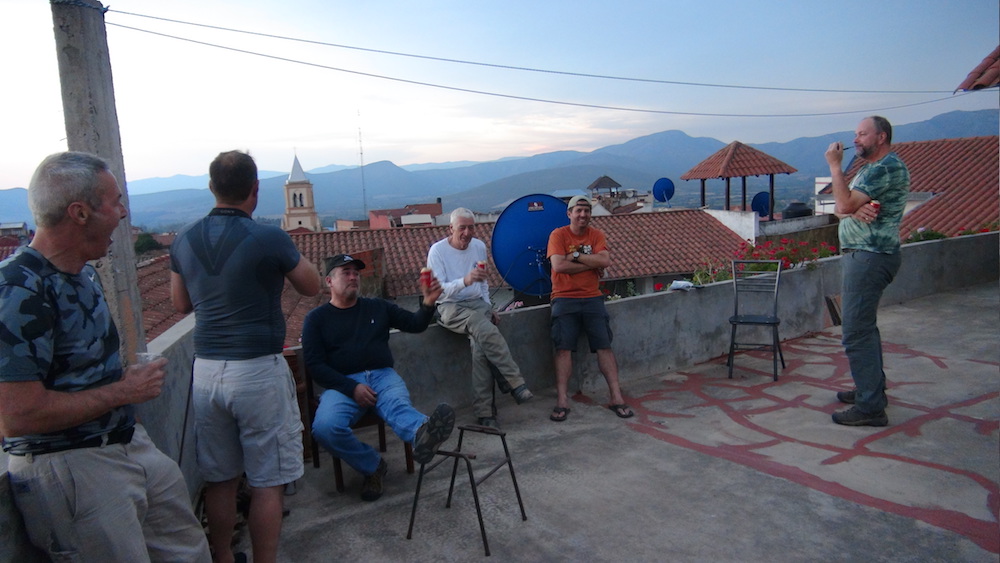
This town was the place where Che Guevara’s body was brought for the world to see that he was truly dead. We were on the “Trail of Che” and Bolivia had already begun to become part of us.
Read Part 2 | Read Part 3 | Read Part 4
